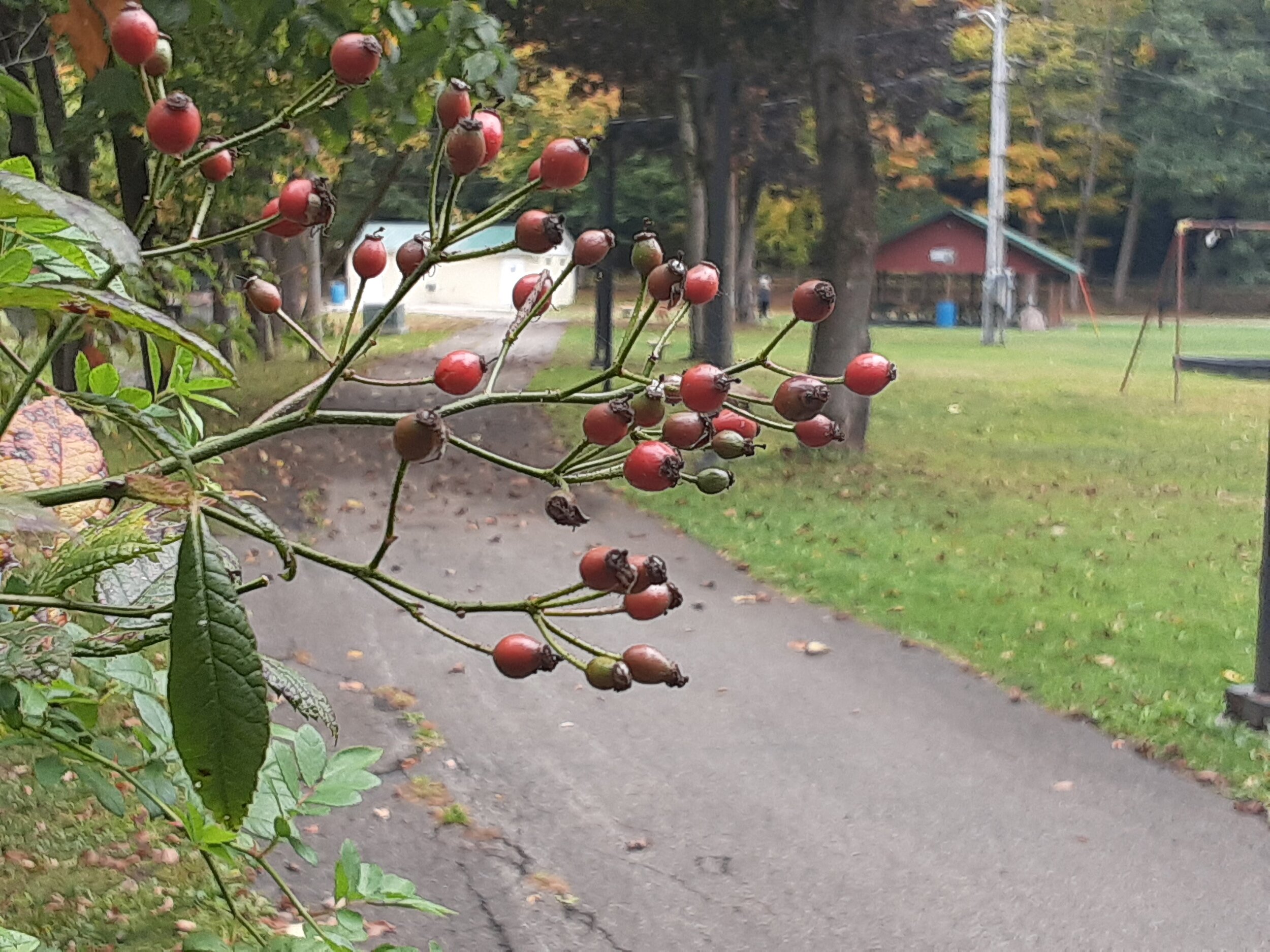Foraging in Falconer Village Park
When we moved to the small village of Falconer, NY last autumn, Patrick and I were wildly lucky to find an apartment close to Falconer Village Park. This 11-acre space offers a little something for everyone, with two baseball diamonds, a tennis court, playground, park shelters, picnic tables, and a trail that winds through the forest. In the mornings, I see crows and robins pacing on the baseball diamond, finding their breakfast in the soil. Walking the trail, I've startled turkey vultures in their nest above my head and seen hawks circling above. Considering how small the wooded area is, the park is home to an impressive number of native species. If you haven't ogled skunk cabbage flowers melting the snow in early spring with their heat generation, you are in for a treat!
During the pandemic this year, Falconer Park has offered me a place to safely encounter other humans (and their dogs) from a distance, and enjoy frequent picnic dinners to boot.
Foraging Rules and Park Management
I recently spoke with Carl Caprino, a supervisor with the Falconer Village Department of Public Works, to learn about park management practices and whether foraging invasive and non-native species might be allowed.
When I visited the park this summer, I noticed that some parts of the baseball field were greener than others. I asked Carl if fertilizer or other lawn treatments have been applied. Carl said no--no fertilizers and very little pesticide is used anywhere in the park.
"The only place we apply pesticides is along the fence by the baseball diamond, and on the gravel." (I believe he was referring to the gravel parking area.) "Nothing is applied to the rest of the field. We do a lot of weedwacking, and that's about it," Carl reported.
"We used to use Roundup for the fence and gravel, but we found out that it might be harmful and switched to a different product, or product blend." Carl didn't have the product(s) with him when we spoke, and he didn't recall the name(s) off the top of his head.
I asked Carl if herbicides have been used to manage the invasive species found in the wooded area. "No, we just let the park be a natural space. We don't worry about it," Carl said. "Especially with the pandemic this year and the park being closed for events, we didn't worry about the appearance of the park."
Carl explained that folks working at the park aren't familiar with the plant species growing there. He hadn't heard of garlic mustard (Alliaria petiolata), for example, and wouldn't be able to identify it as an invasive species in the forested area. For foragers, this is good news. Invasive species are the most likely plants to receive pesticide applications in managed parks and forests, and it can be tough to be certain that a patch is safe to harvest. I avoided making garlic mustard pesto this year with plant material from Falconer Park, since I wasn't sure how the park was managed. I plan to harvest this plant (and other invasive species) freely next spring, hopefully contributing to their control in this diverse little nook.
I was interested in learning how long the Village of Falconer has owned the 11-acre park, and whether the space had been used differently in the past. I was unable to find a history of the space on the Village of Falconer website, and the Chautauqua County Parcel History Database has no record of prior ownership or use.
The park is home to a number of edible and medicinal invasive species, like multiflora rose (Rosa multiflora).
Edible & Medicinal "Weeds" at Falconer Park
I explained to Carl that the only plants I'd recommend foraging in the park are invasive and non-native species. The native species are not abundant and should be left alone. Carl approved of harvesting the following plants:
Invasive species
Along Moon Brook (which runs through the park) and in the wooded area, there is a host of edible and medicinal invasive species. As I suggested previously, garlic mustard is a tasty, tender green that offers a pleasant garlicky-mustardy flavor when picked early in the spring. If you harvest this plant, please try to avoid compacting the soil by leaving the path.
Multiflora rose (Rosa multiflora) produces many white or light pink blossoms that are added to teas and other preparations. After frost, multiflora rosehips (pictured above) turn a deep red color and sweeten up; they taste like strawberries to my palate. (Be sure to spit out the seeds.) The hips are great in teas, herbal syrups, jams, and more.
Japanese knotweed (Polygonum cuspidatum) offers edible young shoots in the early spring, plus medicinal roots that are extremely high in resveratrol, the antioxidant of red wine fame. If you're digging roots, do so in a way that doesn't compromise the aesthetics of the area. Be sure to tidy up when you're done.
You'll also find a bit of Japanese barberry (Berberis thunbergii), a spiny invasive shrub whose roots are used medicinally.
Lawn weeds
A number of edible and medicinal non-native "weeds" can be found in the baseball diamonds and surrounding lawns. These include dandelion (Taraxacum officinale), plantain (Plantago sp.), lush self heal (Prunella vulgaris), and ground ivy (Glechoma hederacea). To respect the aesthetics of the baseball diamond and keep the field safe for athletes, please do not dig for dandelion roots; just harvest the leaves.
It's beyond the scope of this article to go into detail about the uses of these plants. Here are some free resources to start with if you'd like to learn more:
The Chestnut School of Herbal Medicine's Blog Castanea
Never miss an article: Join the Sweet Flag Herbs newsletter to receive an email when a new A Nourishing Harvest monthly article is posted.


